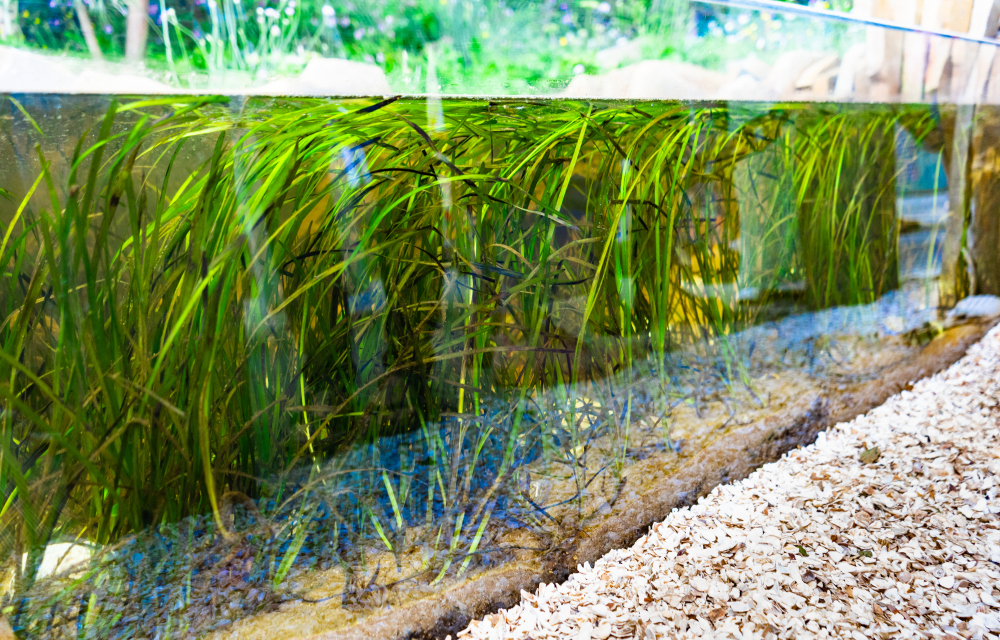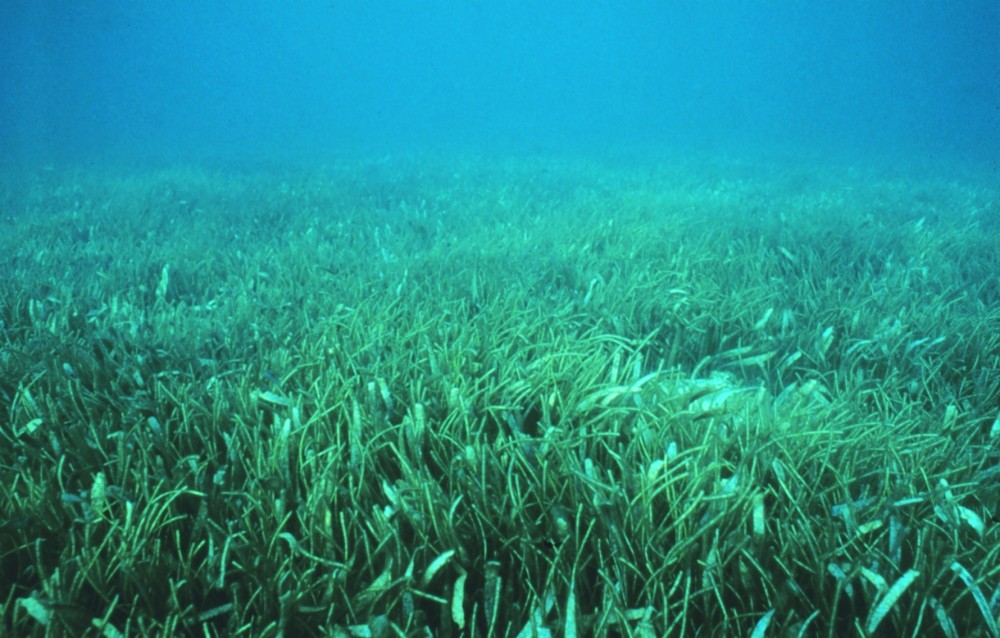We humans bloomin’ love a flower. Sniffing them, looking at them, lopping them off and popping them in vases. On land, there are flowers to be found everywhere, but in the ocean, there’s only one kind of plant that produces flowers, and yes, they even reproduce down there.
Seagrasses are the only true flowering plants that live in marine environments. Their flowers and pollen look a little different, having adapted to carry out the function of flowers on land but with the added difficulty of being underwater. That’s because, once upon a time, they were terrestrial plants, until around 100 million years ago, when they went for a dip and never came back out.
Now they’ve embarked on a new frontier, becoming the first-ever marine flowering plant to appear at London’s Chelsea Flower Show. Seagrasses formed a part of the Seawilding garden (inspired by the charity partner of the same name). It was designed by Ryan McMahon and sponsored by Project Giving Back, marking a horticultural debut the Ocean Conservation Trust hopes will bring these critical but sometimes overlooked marine plants to the forefront.

Image courtesy of the Ocean Conservation Trust
“Seagrass is in decline worldwide and as one of the ocean’s most valuable habitats, we work to highlight its importance and to understand its lifecycle requirements for restoration,” Head of Ocean Habitat Restoration at The Ocean Conservation Trust, Mark Parry, told IFLScience. “The opportunity to showcase the ocean’s plants to a wide audience and contribute our underwater gardening skills to Chelsea created an opportunity for us to tell the story to a broad section of the public, potentially not engaged in ocean conservation.”
Seagrasses face multiple pressures but the greatest could be that a broad section of society is unaware of its importance or locations.
Mark Parry
“Having this conversation in the middle of London helps the Ocean Conservation Trust protect fragile coastal ecosystems. That’s why we wanted to bring seagrass to Chelsea, and it had never been done before, so we thought it would be a good craic, and there are very few people that could have technically completed the task.”
A fitting addition to the Chelsea Flower Show as the only flowering plants that live and reproduce entirely submerged in seawater (except for one genus, Enhalus needs some air), but it got us wondering…
Why do seagrasses have flowers?
Seagrass meadows spread across the ocean, some representing the largest plant on the planet, as they can be made up of an army of clones. As well as being huge, they can also be incredibly old; in 2024, the world’s oldest known living marine plant was estimated to be 1,400 years old. Hell of a birthday for some greenery.
Seagrasses will only grow so deep as, like their terrestrial ancestors, they rely on photosynthesis to survive. Typically, they appear like green grasses with their roots in the seabed, but every now and then some seagrass species go into bloom.
“Since there is no need to attract pollinators, the flowers are purely functional, no bright colours or decorative petals,” explained Parry. “The reproductive shoot appears different to the standard leaf; the leaf is long and striped like other monocots, but the reproductive shoot is branched with inflorescence. The flower is ~50mm long and 6-7mm wide, green in colour, and has a series of spadix protruding from the spathe. If you didn’t know what you were looking for, it would be easy to overlook.”

The Ocean Conservation Trust was the first to bring this kind of underwater gardening to the Chelsea Flower Show.
Image courtesy of the Ocean Conservation Trust
Seagrass pollination
Like flowers on land, the blooms of seagrasses have pollen, which are adapted to get around in the marine environment without the need for an insect intermediate.
The unusual size of the pollen allows it to be carried in currents through the seagrass meadow until it hooks onto the female pistils of the neighbouring plants.
Mark Parry
“The pollen develops in a small detachable theca that falls off during flowering to avoid self-pollination,” explained Parry. “Once free, the theca releases the pollen, which is more akin to a fine filament like cotton wool rather than a fine powder. The unusual size of the pollen allows it to be carried in currents through the seagrass meadow until it hooks onto the female pistils of the neighbouring plants.”
There was a time we thought underwater pollination was achieved exclusively through ocean currents, but we now know that – at least for some seagrass species – this is not the case. Yes, the seas have their own bees (sometimes called idoteas), and in 2016, a study provided experimental evidence that marine flowers can be pollinated by invertebrates. Like bees buzzing between plants, the flowers of the seagrass Thalassia testudinum are visited by microscopic crustaceans and marine worms.
These minute pollinators drop by to feed on some of the seagrass flowers’ delicious and nutritious pollen, but when they wriggle off to find another plant, some of that pollen sticks to them. That’s because the flower has evolved to release its pollen wrapped in mucilage – a substance that’s just as sticky as it sounds – and as the critters hop from flower to flower, they unwittingly pollinate the seagrass.
These seagrasses could still pollinate through water currents alone, but the sea bees can encourage seagrass growth. Very handy considering, as the researchers noted, they’re among the most productive ecosystems in the world. “They improve water transparency, stabilize coastlines and store carbon, and also provide food and shelter to a diverse faunal community,” they wrote in Nature Communications.
The many sea bees
While the sea bees for Thalassia refer to a group of organisms, another was identified for algae: idoteas. These idoteas were found to be common among red algae and that their presence significantly boosted fertilization. They were able to confirm the connection by zooming in on the isopods showing their bodies sometimes picked up the seaweed’s spermatia like pollen sticking to a bee, which the idoteas could then deliver to the necessary reproductive parts by wandering over to female plants.
“The long-held belief that animal-mediated pollination is absent in the sea has recently been contradicted in seagrasses, motivating investigations of other marine phyla,” wrote the authors of the paper published in Science. “This discovery suggests that animal-mediated fertilization could have evolved independently in terrestrial and marine environments and raises the possibility of its emergence in the sea before plants moved ashore.”

Seagrass meadows can stretch for miles.
Save our seagrasses
It’s no great secret that our marine environments are facing a tipping point in many regions, as the combination of overfishing and rising temperatures and acidity is pushing many ecosystems to the brink. Often the focus goes on the larger lifeforms like whales and sharks (who, as the anniversary of JAWS reminds us, do need our help, too), but we can’t forget the vital plants that form some of the most valuable and biodiverse habitats on the planet.y
“Seagrasses face multiple pressures, but the greatest could be that a broad section of society is unaware of its importance or locations,” said Parry. “Everything we do is influenced by the ocean, whether we live far or close to the sea.”
Source Link: One Of The Ocean's "Most Valuable Habitats" Grows The Only Flowers Known To Bloom In Seawater